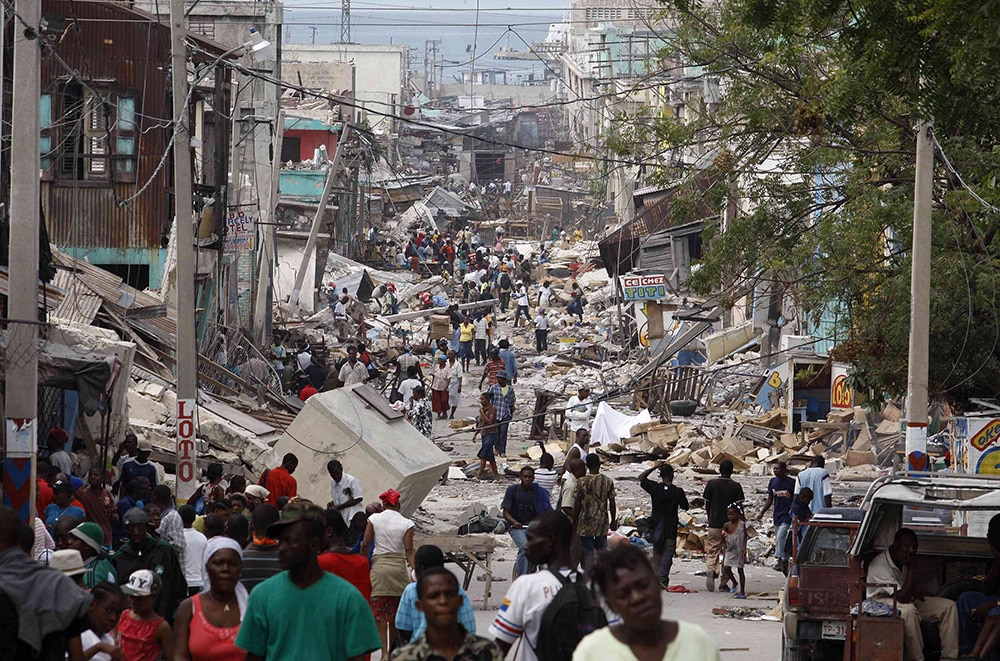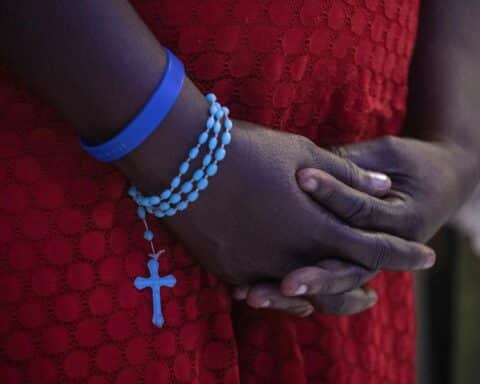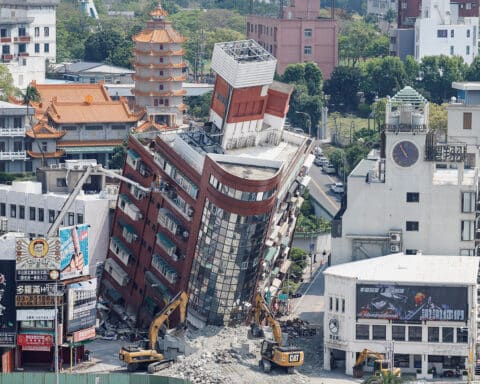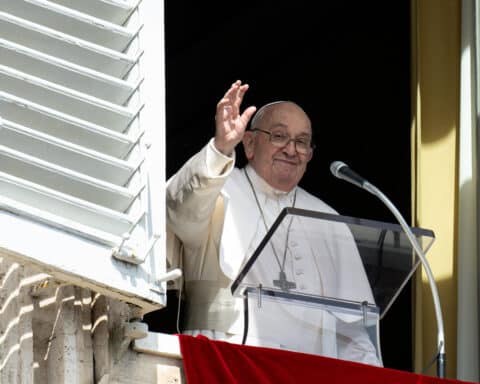In the late afternoon of Tuesday, Jan. 12, 2010, Holy Cross Father Thomas Streit and his colleagues from the University of Notre Dame had just left a meeting inside the Hôtel Montana, located in Haiti’s capital city of Port-au-Prince.
“We had run through the agenda,” said Father Streit, who was in Haiti for a semiannual gathering of an initiative to combat diseases, such as cholera. After the meeting, the group dispersed throughout the hotel compound. Seconds later, the earthquake hit.
“If we hadn’t gotten out early, we would have been crushed,” said Father Streit, who was standing on an open-air balcony several stories above the ground when the earth began to shake.
As the luxury hotel cratered, Father Streit and his colleagues rode the collapse down to the street. Father Streit prayed three times in Latin to the Blessed Mother, “Have mercy on my soul, a sinner.” The building pancaked, but he and his colleagues survived.
| Related Reading |
|---|
|
In Haiti, ‘So many of us lost everything that day’ Editorial: 10 years after the earthquake, Haitians still in desperate need |
“We were really blessed,” Father Streit told Our Sunday Visitor. “It was really a second chance.”
Many others were not as fortunate. Anywhere from 85,000 to 316,000 people — an exact death total has never been established — were killed when the devastating earthquake, which had a magnitude of 7.0, struck Haiti just before 5 p.m.
“It wasn’t the worst earthquake geologically, but it was because of the poverty that there was so much suffering and death, with the lack of building codes and poor construction,” said Father Streit, who stayed in Haiti for several days after the earthquake to help with the emergency response.
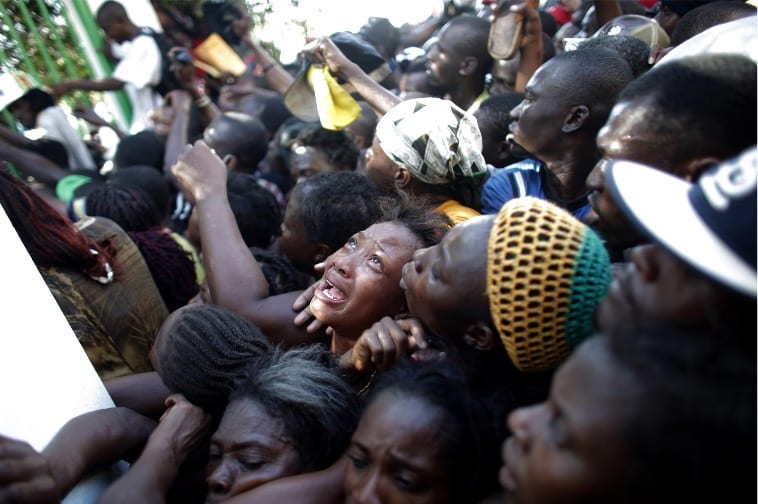
With its epicenter about 16 miles west of the capital, the earthquake leveled entire neighborhoods in Port-au-Prince. Without proper building codes and adequate reinforcement, concrete structures throughout the country disintegrated, killing and trapping their occupants. Many hospitals were destroyed or rendered unusable. Morgues quickly filled to capacity.
“The things I saw over the next few days were just unbelievable,” Father Streit said. “Bodies were stacked up like cordwood on the sides of the road. You’d see ribbons from a little girl’s hair sticking out from under the pile of bodies. It was just horrible. I’ll never forget those images.”
The devastation
The shocking footage from Haiti moved the international community to respond with unprecedented levels of charity and compassion. In a single special weekend collection, U.S. Catholics donated $85 million toward the relief and recovery efforts. Most of those funds were used by Catholic Relief Services for humanitarian relief — supplying food, water, medical aid and temporary housing — for earthquake victims.
“Those efforts went on for a long time, because the devastation was so great,” said Chris Bessey, the country representative for Catholic Relief Services in Haiti. When he arrived in Haiti four years ago, Bessey told Our Sunday Visitor, there was still a lot of earthquake-related rebuilding happening in Port-au-Prince.
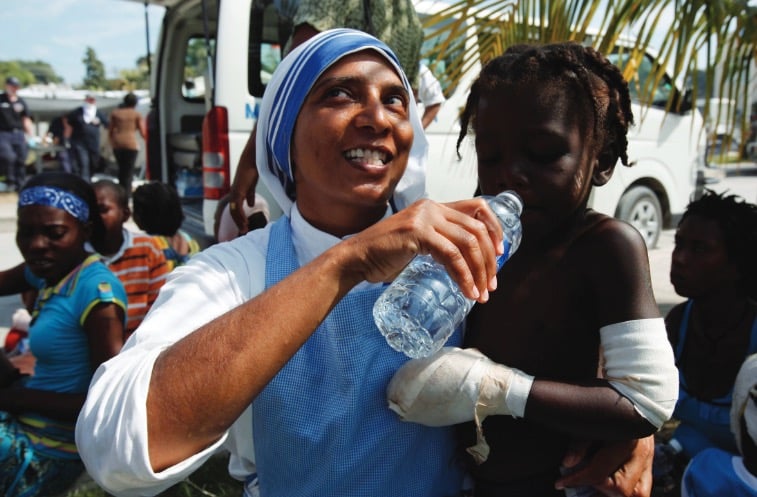
“We previously had focused our programing efforts in rural areas, so working in an urban environment, especially in an urban context on that scale, was new to us,” Bessey said. “But we were so grateful for the outpouring of support to help the programs, to help the Haitian people rebuild their lives and get back to some form of normalcy.”
While agencies such as Catholic Relief Services provided emergency supplies and worked with local partners to provide humanitarian relief on the ground, medical personnel from the United States and around the world treated the injured at makeshift tent hospitals in Haiti.
“We did as much business as possible in the field hospital in terms of patients seen and operations done,” said Father Streit, who estimated that the tent hospital in Léogâne, where he volunteered, treated close to 30,000 patients.
“The whole response to the earthquake was a huge learning experience for us,” said David Adams, the vice president for missions at Cross Catholic Outreach, a Florida-based relief and development ministry that is active in Haiti.
The day before the earthquake, Adams had flown to Port-au-Prince, where he had lunch at the Hôtel Montana. He left that day and traveled west to Les Cayes, where buildings also collapsed from the earthquake and during the aftershocks that followed.
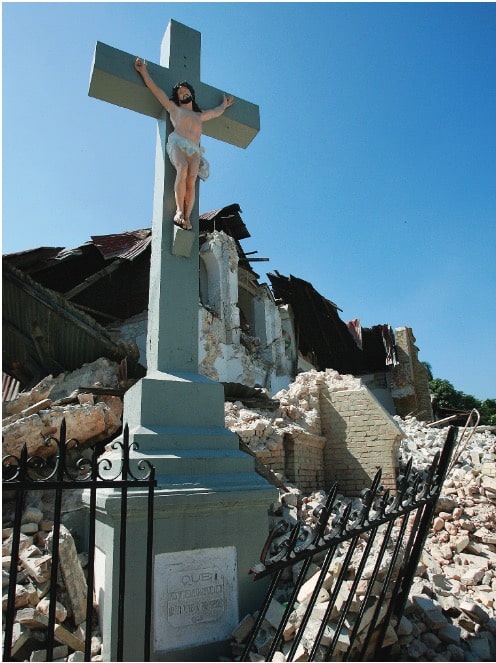
“What happened with the Hôtel Montana, unfortunately, represents what happened in many cases with smaller structures, which were not built to code,” Adams told Our Sunday Visitor. “You had cement houses collapse that didn’t have the appropriate amount of rebar. The damage was devastating in broad swaths of the capital, in particular, because the houses were not well-built.”
Public buildings, including the Presidential Palace, the Port-au-Prince Cathedral and the National Assembly Building, were damaged almost beyond repair. The headquarters of the United Nations Stabilization Mission in Haiti, located in Port-au-Prince, collapsed, killing many inside, including the mission’s chief.
Archbishop Serge Miot of Port-au-Prince was killed when the force of the earthquake threw him off a balcony at the papal nunciature. The archbishop’s tragic death was symbolic of the Hatiian people’s widespread suffering — and a major blow to the local Church in what was and still is the poorest country in the Western Hemisphere.
A string of disasters
“On a good day, Port-au-Prince, in particular, is a difficult city to live in. You have to be resilient to even live in Port-au-Prince and to face all the difficulties of daily life there,” said Jacques Liautaud, the Haiti Project manager for the U.S. Conference of Catholic Bishops.
In the 10 years since the earthquake, Liautaud, who was born in Port-au-Prince, told Our Sunday Visitor that the U.S. bishops’ conference has partnered with sister churches in France, Germany and elsewhere to help rebuild the Catholic Church in Haiti. To date, the U.S. bishops have granted $28 million toward that project. More than 40 Church structures have been rebuilt or newly constructed.
“The earthquake, and everything that has happened since then, including hurricanes, takes a lot of resilience of the population, and you can see that, even more now with all the troubles,” said Liautaud, whose father, brother and two sisters survived the earthquake, though their home was demolished. However, Liautaud’s aunt was killed.
“That’s a very common story,” Liautaud told Our Sunday Visitor. “Few people can claim not to have had any sort of loss in that event.”
The earthquake was the most powerful to hit Haiti since the 18th century. The shocks were felt throughout the country, as well as the neighboring Dominican Republic and parts of nearby Cuba, Jamaica and Puerto Rico. Several aftershocks, some with magnitudes of 5.5 and 5.9, followed in the days after.
At the time, Port-au-Prince was still recovering from tropical storms and hurricanes that had damaged the city’s infrastructure about a year and a half earlier. Coupled with the crippling, widespread poverty and poor housing conditions, Haiti was ill-prepared for such a national disaster.
“And it’s been a string of other natural disasters there over these last 10 years, which has fueled ongoing famine and poverty, and then you throw in cholera outbreaks. … It just never gets you able to put all your focus on permanent building,” said Peter Routsis-Arroyo, CEO of Catholic Charities of the Archdiocese of Miami.
Neighbors from the north
Routsis-Arroyo told Our Sunday Visitor that, after the earthquake, Catholic Charities helped to resettle many Haitians in Miami, where they often had relatives. They arrived traumatized and in need of medical care. The U.S. government granted many of them with temporary protected status that enabled the Haitian refugees to reside legally in the United States.
“A big piece of what we were doing in 2010 was being at the (Miami) airport trying, as they were coming in, to provide them with orientation and some financial help so they could get back on their feet,” said Routsis-Arroyo, who added that Catholic Charities also collected money to help with the relief and recovery efforts in Haiti.
“At the same time, we were involved with helping local Caritas agencies on the ground in Haiti, who knew what was going on,” Routsis-Arroyo said. “There was a warehouse outside of Port-au-Prince that we kept stocked continually for a long time with disaster relief supplies.”
Over the last 10 years, Routsis-Arroyo said the Archdiocese of Miami has also strengthened ties with communities in northwest Haiti by helping local farmers to replant crops, such as coffee, and by working on other development initiatives to create better economic opportunities in that part of the country.
“The Catholic Church is front and center there in Haiti,” Routsis-Arroyo said. “It’s an institution that in the last 10 years has been able to rebuild, and that offers hope for rebuilding and getting the country back on the right track.”
Helping to rebuild
Adams, who was stationed in Haiti from 2001 to 2004 as a U.S. senior foreign service officer, said Cross Catholic Outreach was in a good position to respond in the earthquake’s aftermath. A couple of years earlier, the ministry, which gets most of its funding from private donations, had secured a $4.8 million grant from the U.S. government to combat the spread of HIV/AIDS in Haiti.
“The government was flexible enough to allow Cross Catholic Outreach to carve out a portion of that grant, about $500,000, for disaster response in the wake of the earthquake,” said Adams, who added that the organization shipped hundreds of thousands of meals to Haiti in the quake’s immediate aftermath.
Cross Catholic Outreach, which in normal times focuses on projects pertaining to primary education and drinkable water in poorer countries, also helped to fund a field hospital at the airport in Port-au-Prince. Partner agencies provided emergency supplies to internally displaced people who were forced to move into camps outside the cities.
“Even as we helped with disaster relief and recovery activities, we wanted to help people get out of the camps,” Adams said, adding that his ministry built new permanent houses, designed to be resistant to earthquakes and hurricanes, in targeted neighborhoods. Adams said it took a couple of years after the earthquake for conditions to stabilize.
“The international community helped to improve and rebuild the roads, so there was a lot of construction on the main highways,” Adams said. “And as things have settled down, there has been more business and concerted efforts to draw in more investment to Haiti.”
Bessey, of Catholic Relief Services, said his agency helped to rebuild a hospital in downtown Port-au-Prince and badly damaged neighborhoods with new housing.
“Little by little, we were able to reestablish those communities and get everyone out of the soccer fields [where they were living in tents] and back into their homes,” Bessey said.
Overlooking Port-au-Prince from a nearby hill, Liautaud said the capital has largely been rebuilt and looks “vastly different” from what it did in the weeks after the earthquake.
“If you look at the city today, it’s hard to see where the destruction was, because of a lot of the buildings have gone back up,” he said. “Of course, if you drive through the city, you will see empty blocks, especially where there were residential buildings that were destroyed and haven’t been reconstructed.”
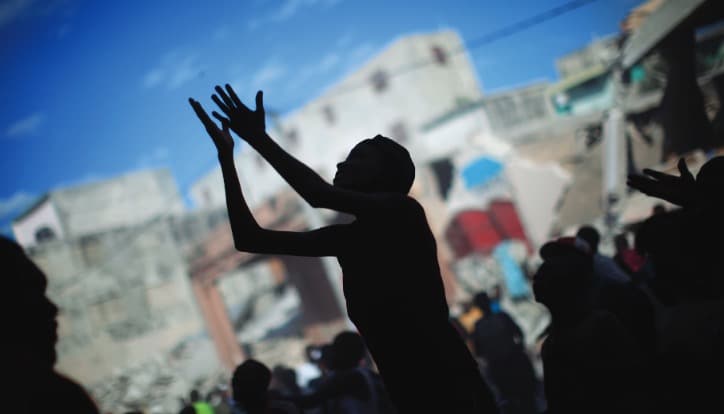
Leaning on their faith
Father Streit, who founded the University of Notre Dame’s Haiti Program — an initiative to eradicate lymphatic filariasis, a debilitating mosquito-borne disease — today spends much of his time in Haiti. He said the wounds from January 2010 are still very much below the surface of the reconstructed cities.
“Every time I go by one of the schools in Léogâne, where I live most of the time, it’s still lying there in rubble,” Father Streit said. “I think about the father I knew well who was digging for his son through rebar and concrete, and how he could hear his son fading, that by the next morning he was gone. I’ll never forget that.”
But alongside that heartbreaking tragedy is a resiliency perhaps only known to people who have grown up in crippling poverty and natural disasters. A couple of mornings after the earthquake, Father Streit recalled sleeping in a different hotel’s courtyard when he heard fruit vendors back on the streets, selling their goods.
“I couldn’t believe it, what resilience they had,” Father Streit said. “And to tell you the truth, we were nervous that the fabric of the society would deteriorate quickly in the aftermath of such a horrendous wound. But the truth was that those people already knew how to adapt because of their history and their economic status. They’ve been poor. They know how to deal with horror, and each person seemed to have a resilience that I never expected.”
In the end, a decade later, Father Streit believes that resilience, in many ways fueled by faith, is the main takeaway from the earthquake.
“We all have that resiliency. It’s just that we haven’t had to tap it as much in our lives — certainly not like that,” he said. “The people there can and did lean very much on their faith. The hunger for the Eucharist is all that much greater because people depend on their faith and God’s promises in Jesus, and they rely on the Spirit to guide them everyday.”
Brian Fraga is a contributing editor for Our Sunday Visitor.
| PROTESTS, POLITICAL INSTABILITY MAJOR SETBACKS FOR HAITIANS |
|---|
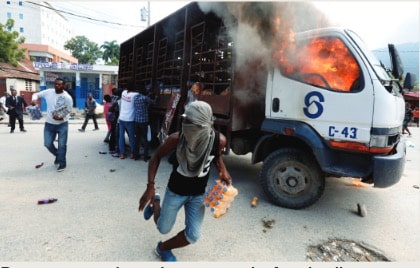 For months at a time, schools in Haiti have been closed, roads have been barricaded and armed gangs have roamed the streets. “This year has been very difficult. Compared to previous years, we’ve achieved much less progress,” said Jacques Liautaud, the Haiti Project Manager for the U.S. Conference of Catholic Bishops. The political stability in Haiti has deteriorated over the last year as mass street protests have flared throughout the country against the government of President Jovenel Moïse, who is trying to fight off calls for his resignation amid a multibillion-dollar corruption scandal. Widespread anger and frustration with the government, combined with systemic corruption and endemic poverty, have boiled over into violence on the streets, leading to scores of people being killed and wounded. The violence has forced schools, businesses, banks and courts to shut down. The instability has also ground construction to a halt. “As you can imagine, when you have these periods of unrest, with barricades and so on, sometimes the construction workers can’t even get to the job sites,” said Liautaud, who helps to oversee church reconstruction projects in Haiti. Liautaud said supply trucks have been attacked and robbed. The office that manages the church construction projects had to close for a month when the unrest began last summer. “Given that we have job sites all around Port-au-Prince and the provincial cities, getting to those sites at these times becomes very complicated,” Liautaud said. “We tried to mitigate the risk by accumulating materials at the job sites so at least the workers can keep working for a time while the roads are blocked.” Last June, the U.S. State Department, citing crime and civil unrest, issued an advisory urging Americans to avoid traveling to Haiti. The State Department also pulled non-emergency U.S. personnel and their family members from the country. “Haiti is in a bad situation now. I would say it’s even worse now than what it was after the earthquake. So many things have ground to a halt,” said Holy Cross Father Thomas Streit, founder of the University of Notre Dame’s Haiti Program. Father Streit said public institutions that need to stay open, such as hospitals, are struggling to keep their doors open amid the deteriorating public safety. Some children went back to school recently but without uniforms, because they made the students targets for some gangs. “I’m worried about things like famine, because if the food distribution system breaks down, then you’re not going to get the food distributed,” Father Streit said. “The roads have been blocked or unsafe for so long, months now, it’s tough, and people don’t know what the solution is.” With no political settlement in sight, daily life has become extremely difficult in the Western Hemisphere’s poorest country, where many people rely on cash remittances from relatives working abroad in the United States, Canada and Europe. Gas shortages in Haiti are getting worse. Public transportation has ground to a halt. The currency has been greatly devalued. A feeling of uncertainty and a sense of hopelessness hover over the country like a toxic cloud. “Because of protest in the streets and highways, we’ve had difficulty in sending food and other supplies, because you never know when the trucks are going to be robbed,” said David Adams of Cross Catholic Outreach. Adams said his ministry had food supplies pre-positioned in the country, which has helped to alleviate some of the complications, some of which are caused by the Haitian government’s own port and customs officials. “They charge very high fees, even for charitable work, because the government sees that as a way to generate revenues,” Adams said. Peter Routsis-Arroyo, CEO of Catholic Charities of the Archdiocese of Miami, said the difficulty of getting goods in and out of Haiti has made relief and recovery work in that country “more of a challenge than ever.” “Because of the natural disasters that have happened there over the years, together with the problems and challenges with the government, it’s just making everything there an ongoing challenge,” Routsis-Arroyo said. |
| Helping the Church Rebuild |
|---|
|
The January 2010 earthquake leveled much of Haiti’s infrastructure and public institutions, including the Catholic Church, which sustained more than an $150 million in estimated damages.
“Churches, rectories and schools were damaged, so were religious communities’ houses of formation and novitiates,” said Jacques Liautaud, the Haiti project manager for the U.S. Conference of Catholic Bishops. In late 2010, the U.S. bishops conference joined Church leaders from Haiti and elsewhere, including sister churches from Germany, France, Latin America and the Vatican, in a new partnership aimed to rebuild the Catholic Church in Haiti. Together they formed the Partnership for Church Reconstruction, known as PROCHE for its initials in French. “They created PROCHE to manage the reconstruction effort, to ensure proper accounting of funds and for technical management, so that the structures that were built were done according to norms and international building codes, particularly in terms of earthquake resistance and hurricanes,” said Liautaud, who sits on PROCHE’s joint steering committee. Liautaud told Our Sunday Visitor that more than 40 church building projects in Haiti to date have been completed, at a cost of around $28 million, with several other major church properties currently under construction in and around Port-au-Prince. The rebuilding projects that PROCHE has overseen include the Sacré-Coeur church in Port-au-Prince, the Church of St. Francis of Assisi in Grand Goave and the new headquarters of the Conference of Haitian Religious in Port-au-Prince. Liautaud said Church leaders decided to form a collaborative like PROCHE instead of forming an NGO-type organization that “goes in and rebuilds and then gets out.” “That took longer, because we tried to do everything by consensus,” Liautaud said. “We had to set up a construction management office from scratch in Port-au-Prince, creating the organization and its structure and processes. We set up an office, hired people, and we were able to start operating in November 2011.” The U.S. Conference of Catholic Bishops has provided most of the funding, though the other PROCHE member churches also have contributed to the cost of rebuilding. “It’s not just us funding a project,” Liautaud said. |

